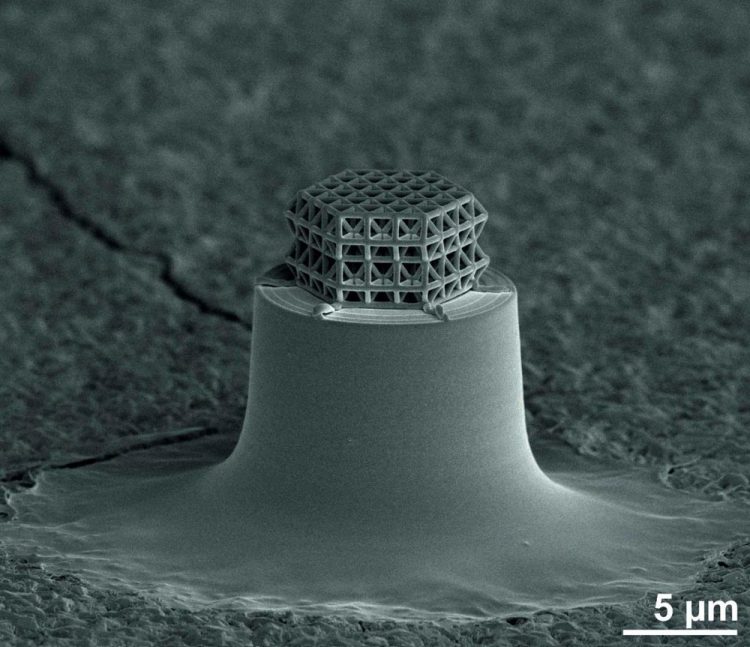Smallest lattice structure worldwide

The smallest lattice in the world is visible under the microscope only. Struts and braces are 0.2 µm in diameter. Total size of the lattice is about 10 µm. Photo: J. Bauer / KIT
KIT scientists now present the smallest lattice structure made by man in the Nature Materials journal. Its struts and braces are made of glassy carbon and are less than 1 µm long and 200 nm in diameter. They are smaller than comparable metamaterials by a factor of 5. The small dimension results in so far unreached ratios of strength to density. Applications as electrodes, filters or optical components might be possible. (DOI: 10.1038/nmat4561)
“Lightweight construction materials, such as bones and wood, are found everywhere in nature,” Dr.-Ing. Jens Bauer of Karlsruhe Institute of Technology (KIT), the first author of the study, explains. “They have a high load-bearing capacity and small weight and, hence, serve as models for mechanical metamaterials for technical applications.”
Metamaterials are materials, whose structures of some micrometers (millionths of a meter) in dimension are planned and manufactured specifically for them to possess mechanical or optical properties that cannot be reached by unstructured solids. Examples are invisibility cloaks that guide light, sound or heat around objects, materials that counterintuitively react to pressure and shear (auxetic materials) or lightweight nanomaterials of high specific stability (force per unit area and density).
The smallest stable lattice structure worldwide presented now was produced by the established 3D laser lithography process at first. The desired structure of micrometer size is hardened in a photoresist by laser beams in a computer-controlled manner. However, resolution of this process is limited, such that struts of about 5 – 10 µm length and 1 µm in diameter can be produced only. In a subsequent step, the structure was therefore shrunk and vitrified by pyrolysis. For the first time, pyrolysis was used for manufacturing microstructured lattices. The object is exposed to temperatures of around 900°C in a vacuum furnace. As a result, chemical bonds reorient themselves. Except for carbon, all elements escape from the resist. The unordered carbon remains in the shrunk lattice structure in the form of glassy carbon. The resulting structures were tested for stability under pressure by the researchers.
“According to the results, load-bearing capacity of the lattice is very close to the theoretical limit and far above that of unstructured glassy carbon,” Prof. Oliver Kraft, co-author of the study, reports. Until the end of last year, Kraft headed the Institute for Applied Materials of KIT. This year, he took over office as KIT Vice President for Research. “Diamond is the only solid having a higher specific stability.”
Microstructured materials are often used for insulation or shock absorption. Open-pored materials may be used as filters in chemical industry. Metamaterials also have extraordinary optical properties that are applied in telecommunications. Glassy carbon is a high-technology material made of pure carbon. It combines glassy, ceramic properties with graphite properties and is of interest for use in electrodes of batteries or electrolysis systems.
###
Approaching Theoretical Strength in Glassy Carbon Nanolattices, J. Bauer, A. Schroer, R. Schwaiger, and O. Kraft, DOI 10.1038/nmat4561
Other press releases on this subject:
https:/
https:/
For further information, please contact:
Kosta Schinarakis, PKM – Science Scout, Phone: +49 721 608 41956, Fax: +49 721 608 43658, E-mail: schinarakis@kit.edu
Karlsruhe Institute of Technology (KIT) pools its three core tasks of research, higher education, and innovation in a mission. With about 9,400 employees and 25,000 students, KIT is one of the big institutions of research and higher education in natural sciences and engineering in Europe.
KIT – The Research University in the Helmholtz Association
Since 2010, the KIT has been certified as a family-friendly university.
This press release is available on the internet at http://www.
Media Contact
All latest news from the category: Materials Sciences
Materials management deals with the research, development, manufacturing and processing of raw and industrial materials. Key aspects here are biological and medical issues, which play an increasingly important role in this field.
innovations-report offers in-depth articles related to the development and application of materials and the structure and properties of new materials.
Newest articles

A universal framework for spatial biology
SpatialData is a freely accessible tool to unify and integrate data from different omics technologies accounting for spatial information, which can provide holistic insights into health and disease. Biological processes…

How complex biological processes arise
A $20 million grant from the U.S. National Science Foundation (NSF) will support the establishment and operation of the National Synthesis Center for Emergence in the Molecular and Cellular Sciences (NCEMS) at…

Airborne single-photon lidar system achieves high-resolution 3D imaging
Compact, low-power system opens doors for photon-efficient drone and satellite-based environmental monitoring and mapping. Researchers have developed a compact and lightweight single-photon airborne lidar system that can acquire high-resolution 3D…





















